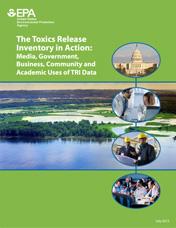TRI Data Uses
On this page:
What Can You Do With the TRI?
For nearly 30 years, individuals and organizations have been relying on the Toxics Release Inventory as a powerful tool for environmental protection. Have you been wondering what you can do with TRI data?
The table below includes recent examples of how people have been putting TRI information to work.
| TRI User Type | How TRI Can Be Used | Data Use Examples |
|---|---|---|
| Citizen/Communities/NGOs | Conduct analyses and risk assessments; identify potential public health concerns | |
| Government | Prioritize environmental targets; evaluate effectiveness of environmental policies | |
| Academia | Research public exposure to toxic materials; assess environmental justice concerns | |
| Industry | Track progress toward corporate sustainability goals; identify opportunities for cost savings | |
| Media | Monitor trends in toxic chemical releases in communities nationwide; investigate corporate environmental performance |
Please note that many of the links in the table go to non-EPA websites. The TRI data uses referenced in these linked materials are provided as examples; EPA is not endorsing the individuals, groups, and organizations who have used TRI data or their products.
Examples of TRI Data Users
Citizens/Communities/NGOs
Informed through the TRI about what local facilities are doing, community groups and local government officials can approach companies about implementing pollution prevention projects, reducing emissions, and improving safety measures. TRI information also helps communities recognize “good neighbor” facilities that have improved environmental performance.
Individuals and community organizations can also use TRI data as the basis for conducting environmental education initiatives, campaigning for more comprehensive environmental policies, and investigating public health concerns.
Government
Federal agencies and state and local governments use TRI data to help identify policy objectives and support progress toward organizational goals. TRI data are used to set environmental targets, track environmental performance and gauge the impact of environmental policies.
Academia
The academic community conducts a variety of research with TRI data, either alone or in combination with other datasets. This research includes chemical specific analyses, investigations into corporate environmental performance, national trends, and epidemiological studies. In addition, academics use the TRI to evaluate the impact of environmental policies, investigate the public health implications of exposure to toxic materials, and assess environmental justice concerns, among other topics.
Industry
Companies are increasingly using TRI data as a metric for evaluating progress toward achieving sustainability goals. Many have programs in place to manage their environmental impact, focused on either total pounds of TRI chemicals released or TRI chemicals generated per unit of production. Companies have found TRI to be a useful tool for assessing their progress on pollution prevention and identifying opportunities for improving performance. Many companies publicize their own TRI data in corporate sustainability reports that inform current and potential customers about their environmental progress.
Media
News organizations frequently cite TRI data in articles examining trends in toxic chemical release quantities, analyzing the performance of particular industry sectors, and evaluating environmental conditions. This is particularly the case in states and communities where large industry sectors like electric utilities and metal mining are located.

